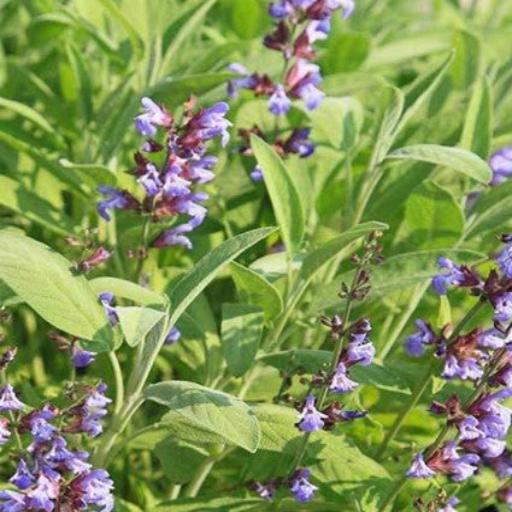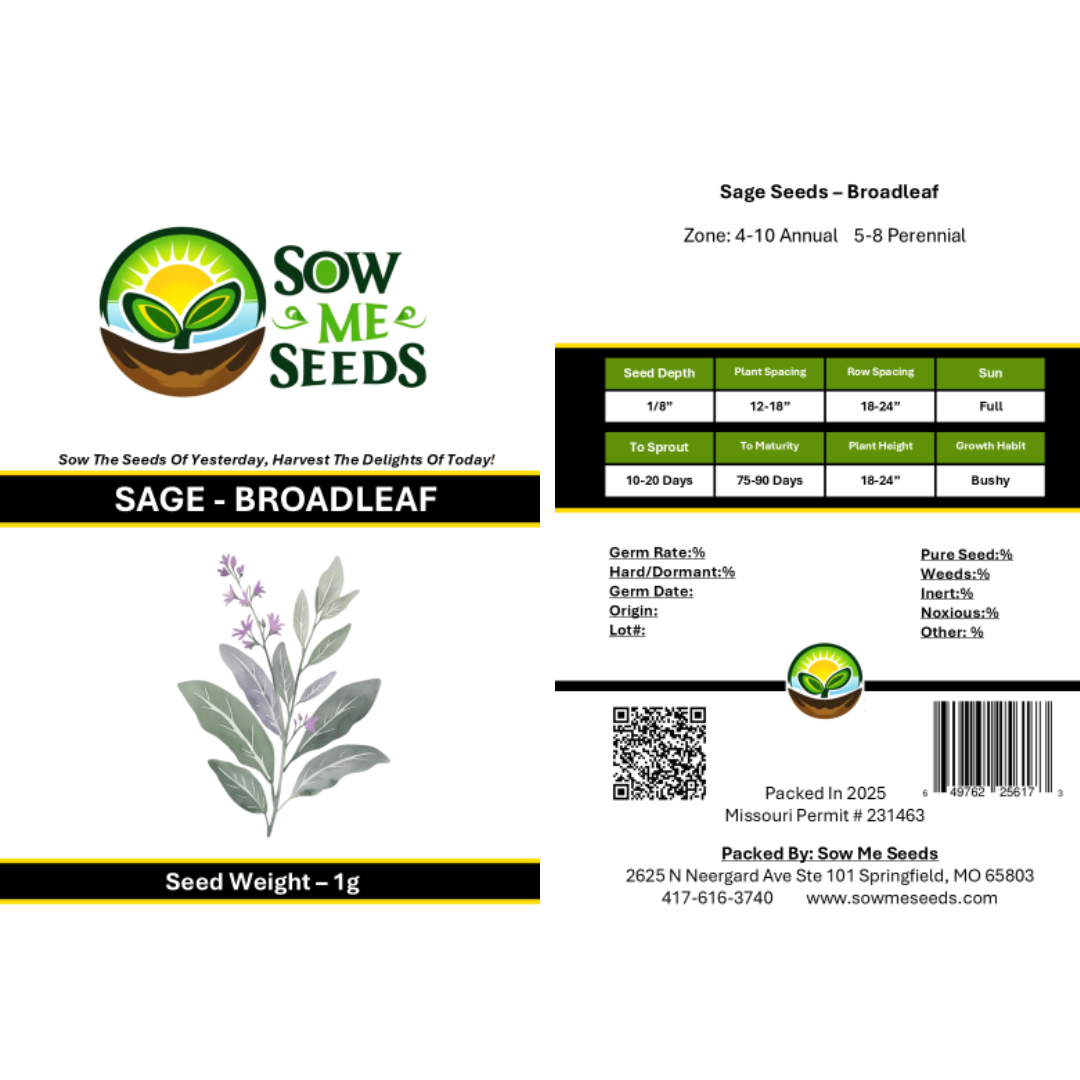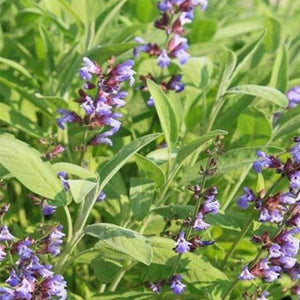- Hardiness Zone: 4-10 Annual
- Hardiness Zone: 5-8 Perennial
Sunlight: Choose a location that receives full sun for at least 6-8 hours a day. Sage thrives in warm, sunny conditions.
Soil: Prefers well-drained, sandy or loamy soil with a pH between 6.0 and 7.0. Sage does best in soils that are not overly rich, as too much fertility can reduce the intensity of its flavor.
When to Plant: Sage is best planted in the spring after the danger of frost has passed. In warmer climates, it can also be planted in the fall. Start seeds indoors 6-8 weeks before the last expected frost date, or purchase transplants from a nursery.
Starting Indoors: Sow seeds 1/4 inch deep in seed-starting mix. Keep the soil moist and maintain a temperature of 70-75°F (21-24°C). Transplant seedlings outdoors when they are 4-6 inches tall and all danger of frost has passed.
Direct Sowing:Sage seeds can also be sown directly in the garden after the last frost date. Sow seeds 1/4 inch deep and 12-18 inches apart in rows spaced 18-24 inches apart. Thin seedlings to 18-24 inches apart once they are a few inches tall to allow enough space for the plants to mature.
Watering: Keep the soil consistently moist but not waterlogged until the plants are established. Once established, sage is drought-tolerant and requires only moderate watering. Water the plants at the base to avoid wetting the leaves, which can lead to fungal diseases.
Fertilization: Sage does not require heavy fertilization. Apply a light application of compost or a balanced fertilizer at planting time. Over-fertilizing can lead to excessive foliage growth with less intense flavor.
Pruning: Regularly prune sage to encourage bushy growth and prevent the plant from becoming leggy. Harvest leaves as needed once the plant is established, but avoid heavy harvesting in the first year to allow the plant to develop a strong root system. In late fall, cut back the stems to prevent winter damage and promote healthy growth in the following season.
Mulching and Weeding: Apply a layer of mulch around the plants to retain soil moisture, suppress weeds, and keep the soil temperature consistent. Hand-pull weeds carefully to avoid disturbing the shallow roots of the sage.
Pest and Disease Management: Sage is relatively pest-resistant but can occasionally suffer from aphids, spider mites, and fungal diseases like powdery mildew. Use organic pest control methods like neem oil or insecticidal soap if necessary. Ensure good air circulation to prevent fungal issues.
When to Harvest: Sage leaves can be harvested once the plant is well-established, typically in the second year of growth. The best time to harvest is in the morning after the dew has dried but before the heat of the day.
How to Harvest: Use scissors or pruning shears to cut leaves from the plant. Avoid harvesting more than one-third of the plant at a time to ensure continued healthy growth. Regular harvesting encourages bushy growth and improves the flavor of the leaves.
Storing Fresh Sage:Fresh sage leaves can be stored in the refrigerator for up to a week. Place the leaves in a plastic bag or wrap them in a damp paper towel to retain moisture. For longer storage, sage can be dried or frozen.
Culinary Uses:Broad Leaved Sage is versatile and can be used fresh or dried in a variety of dishes. It is commonly used to flavor meats, especially pork and poultry, as well as in stuffing, soups, sauces, and teas. The leaves can also be used to make sage butter or infused in oils and vinegars.
Why You’ll Love It
Classic Culinary Herb: A staple for stuffing, meats, roasted veggies, and teas.
Soft, Silvery Leaves: Velvety foliage adds texture and color to gardens and bouquets.
Drought-Tolerant: Thrives in hot, dry conditions once established.
Cold-Hardy Perennial: Returns year after year in zones 5 and up.
Plant Characteristics
Height: 18–30 inches
Growth Habit: Upright, bushy perennial with woody stems
Leaf Type: Broad, oval, silvery-green leaves with a soft texture
Days to Maturity: 75–85 days
Hardiness: Perennial in zones 5–9
Flavor and Culinary Uses
Flavor: Strong, earthy, and slightly peppery with a hint of pine and lemon
Culinary Uses: Used fresh or dried in meats, poultry dishes, stuffings, teas, and compound butters
Companion Planting Tips
Good Companions: Rosemary, thyme, cabbage, and carrots
Avoid Planting Near: Cucumbers (can affect their flavor)
Bonus Benefit: Repels cabbage moths, carrot flies, and beetles
Common Issues and Solutions
Leggy Growth: Prune regularly to encourage bushy, compact growth
Powdery Mildew: Improve airflow and avoid overhead watering
Overwatering: Let soil dry between waterings to prevent root rot
Seeds Per Packet
| 1g | Approximately 53 |
| 3g | Approximately 159 |
Why You’ll Love It
Classic Culinary Herb: A staple for stuffing, meats, roasted veggies, and teas.
Soft, Silvery Leaves: Velvety foliage adds texture and color to gardens and bouquets.
Drought-Tolerant: Thrives in hot, dry conditions once established.
Cold-Hardy Perennial: Returns year after year in zones 5 and up.
Plant Characteristics
Height: 18–30 inches
Growth Habit: Upright, bushy perennial with woody stems
Leaf Type: Broad, oval, silvery-green leaves with a soft texture
Days to Maturity: 75–85 days
Hardiness: Perennial in zones 5–9
Flavor and Culinary Uses
Flavor: Strong, earthy, and slightly peppery with a hint of pine and lemon
Culinary Uses: Used fresh or dried in meats, poultry dishes, stuffings, teas, and compound butters
Companion Planting Tips
Good Companions: Rosemary, thyme, cabbage, and carrots
Avoid Planting Near: Cucumbers (can affect their flavor)
Bonus Benefit: Repels cabbage moths, carrot flies, and beetles
Common Issues and Solutions
Leggy Growth: Prune regularly to encourage bushy, compact growth
Powdery Mildew: Improve airflow and avoid overhead watering
Overwatering: Let soil dry between waterings to prevent root rot
Seeds Per Packet
| 1g | Approximately 53 |
| 3g | Approximately 159 |




Share and get 15% off!
Simply share this product on one of the following social networks and you will unlock 15% off!